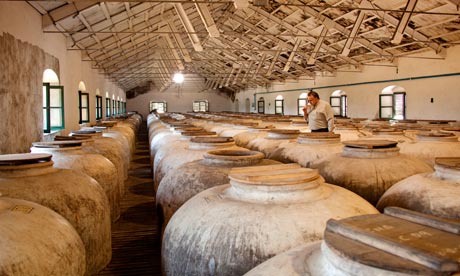
Stick a pin in the centre of a map of Andalucía and you might well hit Montilla. Geographically this is the heart of Spain's deep south, with Seville to the west and Granada over the mountains to the east. But as I thunder up the deserted motorway towards Córdoba from Málaga airport, I nearly miss the undulating vineyards that are the source of Montilla-Moriles fortified wines. And as most of the wineries are small affairs in the folds of the sierra, they, too, remain under the radar, as discreet as their brands. Only the determined traveller finds them – but I discover the effort pays off.
Moriles, to the south, is one half of this D.O. (Denominación de Origen) classification but the town of Montilla is the boss, on the edge of a rolling sierra of white limestone, where the pedro-ximénez grape flourishes. A close cousin of sherry in strength and flavour, Montilla-Moriles wines are not easy to track down. You can order a fragrant, dry fino, a nutty amontillado (named after Montilla), a voluptuous palo cortado or a figgy oloroso in Cordoba, but they're rare further afield. Only 10 of the 170 producers export their nectar.
So it's supremely rewarding to stop off here, tour a bodega or three and bask in a mellow little-visited vino-world (bodegas such as Gonzalez Byass in Jerez are visited by thousands of tourists a day). Earthy, authentic and just about surviving the economic storms, the area is at its liveliest in the grape harvest in late August and early September (Spain's first of the year), when the hills hum with activity and party-time kicks off in Montilla.
My first destination is Lagar Blanco, a few miles east of town, owned by agronomist and oenologist Miguel Cruz. As we twist through the chalky hills, he explains the importance of climatic extremes (from furnace-like heat in summer to bitter cold in winter) for the grapes and how this wine can be dated back to the Romans.
At the summit of Cerro San Juan, his immaculate lagar (wine press) commands fantastic views, but it is in the lofty, whitewashed interior that I begin to appreciate the complexities of the wine process, from the naturally sweet grapes to the solera system of ageing, where younger wine is added to old as it ferments in the casks. The tour ends on a high note, with a tasting of delicate fino straight from the barrel, followed by a 20-year-old amontillado that is pure heaven – and only €12 a bottle.
Different style, different hilltop, different wines – this time Lagar La Primilla, between vineyards and olive groves. The first things you see at this family winery are two giant Ali Baba-style tinajas (earthenware jars), local icons of grape-juice storage that today are supplanted by huge cement containers. Cheerful Charo Jiménez leads the visit through this typically Andalucían establishment, part home, part winery, with a courtyard ablaze with geraniums. Although the wines do not match the exceptional quality of Lagar Blanco, it is a delight to sip them in the cosy tasting-room, accompanied by plate after plate of homemade tapas drizzled with their own olive oil, brought out by Charo's niece.
Montilla is a busy working town spilling downhill from its medieval heart, short on postcard prettiness but proud of its bodegas, its 16th-century convent where unseen nuns sell biscuits through a revolving hatch, and its workshops where oak wine casks are still made by hand. The two imposing buildings on the main street are Alvear (the oldest bodega in Andalucía, founded in 1729) and Pérez Barquero (1905). Tours take in silent, shadowy "cathedrals" where hundreds of barrels of wine, some decades old, are stacked to the rafters.
But I zip round the corner to the 80-year-old Taberna Bolero. Here I sample succulent Huelva prawns followed by tender pork cheeks cooked in a reduction of oloroso, all washed down with the house fino. It's lunchtime, the place is packed, and the narrow, beamed bar, plastered with vintage photos, reverberates with guttural Andaluz, while every local without exception knocks back fino.
It makes me wonder if perhaps there is little reason for Montilla-Moriles to export their wines. Maybe they prefer to preseve them as one of Spain's most intoxicating secrets, in all senses.
• Lagar Blanco (+34 696 875391, lagarblanco.es) tour, tasting and tapas €8pp, plus €10 an hour for translator if needed, lunches available. Lagar La Primilla (+34 616 111392, laprimilla.es) tour, tasting and tapas €12pp. Taberna Bolero, Fuente Alamo 9, has house fino from €1.20. Stay at Hacienda La Vereda (+34 957 335301, haciendalavereda.es), 15 minutes south-east of Montilla with doubles from €55. For tailormade bodega tours try Bacus Travel & Tours (+34 957 022063, bacustravel.es) More information on Montilla wines at rutadelvinomontillamoriles.com

